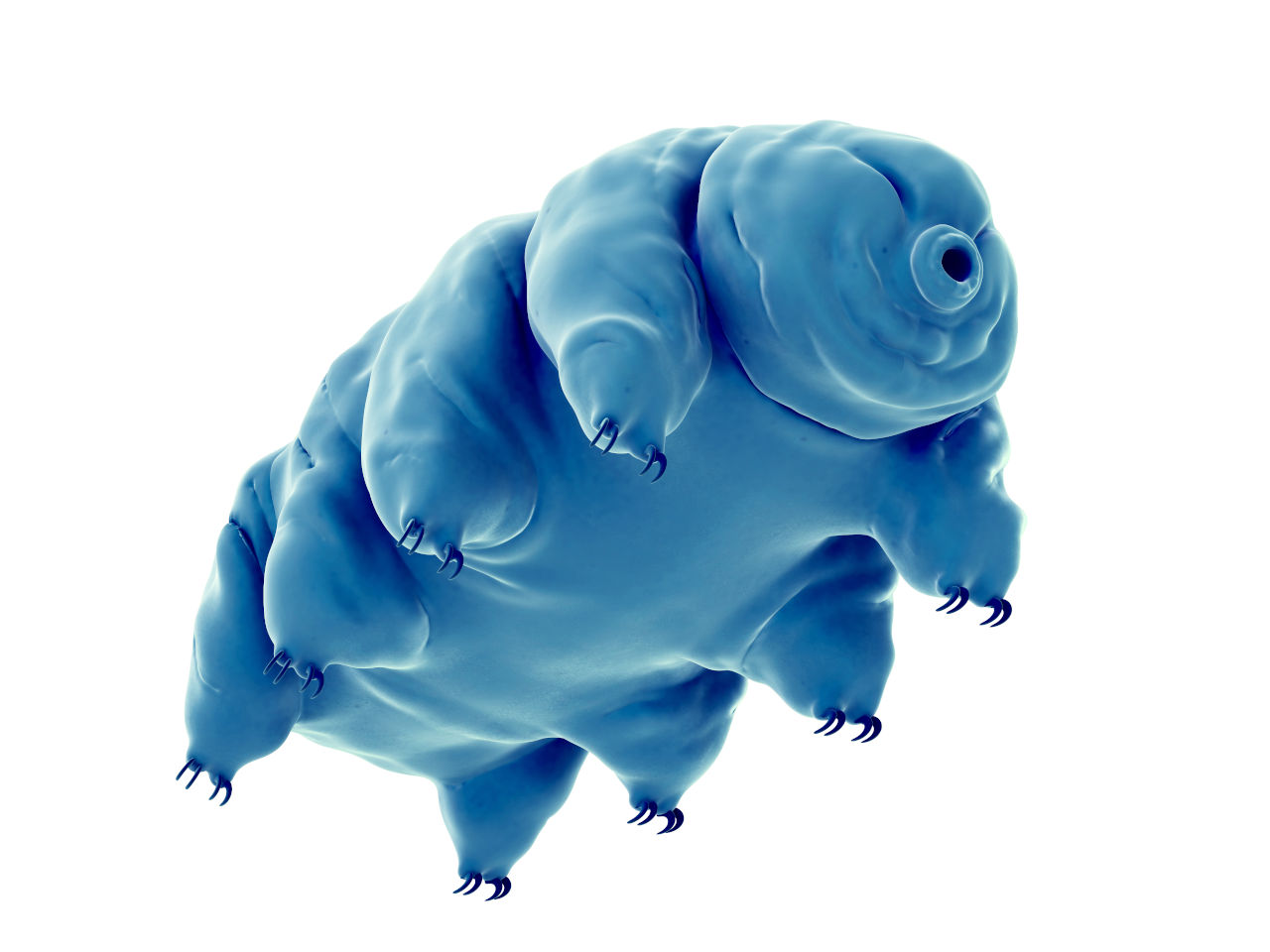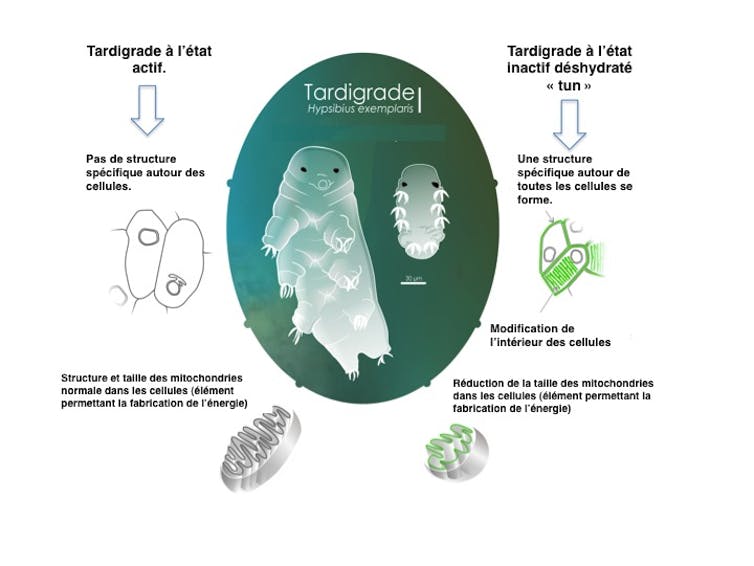The mystery of tardigrades' extreme resistance finally solved?
September 2007. A Russian rocket lifts off from the Baikonur Cosmodrome in Kazakhstan, carrying strange little creatures measuring just one millimeter in length on a ten-day journey around the Earth. These are tardigrades, part of the European Space Agency's (ESA) Foton-M3 space program.
Simon Galas, University of Montpellier and RICHAUD Myriam, University of Montpellier

A strange fate for these astronaut tardigrades, which were all aquatic when they first appeared on Earth (probably since the Cambrian period some 500 million years ago).
Tardigrades, also known as water bears, have four pairs of legs and a pair of small eyes. With 1,400 known species today, they can be found all over the world, from the peaks of the Himalayas to the depths of the oceans.
Tardigrades can lose 95% of their water
Terrestrial tardigrade species retain a memory of their aquatic origins. As soon as the thin film of water covering its body disappears, the tardigrade undergoes an active transformation that causes it to lose 95% of its water and reduce in size by almost 40%. In this state, the tardigrade resembles a small barrel, hence the name "tun" used by Anglo-Saxons to designate it in this particular state, which is a state ofanhydrobiosis.
Anhydrobiosis is a state of slowed life induced by dehydration. In this particular state, tardigrades are able to withstand extreme conditions.
During their stay in low Earth orbit (altitude 258-281 km above sea level), these suspended tardigrades were exposed to the combined action of the vacuum of space, cosmic rays and extreme ultraviolet radiation.
Back on Earth, 12% of these astronaut tardigrades were successfully awakened by simply placing a drop of water on their bodies. This spectacular awakening, which takes less than five minutes in some species, astonished scientists and established tardigrades as the only animals capable of surviving the combined action of the vacuum of space, cosmic radiation and ultraviolet rays in a real-life situation.
One might think that this state of anhydrobiotic or "tun" slowed life would enable tardigrades to withstand only the vacuum of space and its low pressure (10 -6 Pascal), but this is not the case. Tardigrades in the same anhydrobiotic state have been subjected to pressures of up to 7.5 Gigapascals. This pressure corresponds to the pressure of the rock on your shoulders if you were to descend 180 km into the earth's mantle!
What happens in the cells of dehydrated tardigrades?
Until today, no one had tried to see what happens inside a tardigrade when it transforms into a "tun".
Working in partnership with two laboratories from the CNRS and the University of Montpellier, we have produced images for the first time using high-resolution microscopy techniques. The images collected using transmission electron microscopy enabled us to take a journey inside a tardigrade anhydrobiota.
An electron microscope uses electrons to illuminate the object to be observed and can magnify up to 5 million times, whereas an optical microscope, which illuminates the object to be observed with light (photons), can only magnify a maximum of 2,000 times. Electron microscopes, for example, are capable of photographing viruses.
The observation of these tardigrade images was the subject of a scientific paper in the international journal Nature Scientific Reports.

Simon Galas, Author provided
It all starts with dehydration of the animal, resulting in the loss of almost all its water. At the same time, the interior of the tardigrade organizes itself and all the structures that make up a tardigrade cell remain unchanged, such as the cell nucleus containing the chromosomes or the mitochondria that produce the cell's energy. In fact, the whole cell appears to be a miniaturized version of the original. Overall cell miniaturization of almost 40%.
Something unexpected appears in the images
A molecular wall surrounding all tardigrade cells is gradually built up, reaching a thickness of 100 nanometers in places. This is very, very large compared with the membrane that normally surrounds a cell, even in humans. This intercellular rampart, unknown until now, is perhaps the secret of the tardigrade's resistance to being pulverized by high pressures, which no other living organism could withstand. Research into this rampart could perhaps lead to the discovery of new ultra-resistant materials for the environmentally-friendly industries of the future.

Simon Galas, Author provided
One clue may help to explain what this special bulwark is made of. Professor Takekazu Kunieda of the University of Tokyo recently discovered the existence of a particular class of proteins in tardigrades that are capable of vitrifying dehydrated tardigrades, as demonstrated by a laboratory at the University of North Carolina in the USA.
But what happens to this intercellular rampart when a drop of water is placed on the back of the anhydrobiotic tardigrade? Electron microscopy images show that the rampart gradually disappears as the tardigrade emerges from its slowed-down state, disappearing completely after just 24 hours.
We don't yet know whether this newly-discovered protective bulwark is made only by the tardigrade species(Hypsibius exemplaris) reared in our laboratory, or by other tardigrade species.
Recent data from the sequencing of the first tardigrade genomes has provided us with a few surprises, such as the presence of a set of genes unknown in other living species, the functions of which are only just beginning to be studied by biologists. This discovery sheds further light on the ability of tardigrades to protect themselves against aggression of all kinds, and to achieve the high levels of resistance for which they are renowned.![]()
Simon Galas, Professor of Genetics and Molecular Biology of Aging, CNRS - Faculty of Pharmacy, University of Montpellier and RICHAUD Myriam, Doctor of Molecular and Cellular Biology, University of Montpellier
This article is republished from The Conversation under a Creative Commons license. Read theoriginal article.